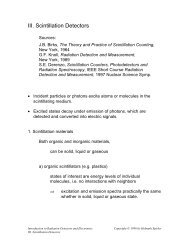Introduction to radiation-resistant semiconductor devices and circuits
Introduction to radiation-resistant semiconductor devices and circuits
Introduction to radiation-resistant semiconductor devices and circuits
Create successful ePaper yourself
Turn your PDF publications into a flip-book with our unique Google optimized e-Paper software.
One of the most powerful measures against detec<strong>to</strong>r leakage current is<br />
segmentation. For a given damage level, the detec<strong>to</strong>r leakage current per signal<br />
channel can be reduced by segmentation. If a diode with a leakage current of<br />
10 μA is subdivided in<strong>to</strong> 100 subelectrodes each with its own signal processing<br />
channel, the DC current in each channel will be 100 nA <strong>and</strong> shot noise reduced by<br />
a fac<strong>to</strong>r of 10. This is why large area silicon tracking detec<strong>to</strong>rs can survive in the<br />
LHC environment. Fortui<strong>to</strong>usly, increased segmentation is also required <strong>to</strong> deal<br />
with the high event rate. Pixel detec<strong>to</strong>rs with small electrode areas offer great<br />
advantages in this regard.<br />
The most severe restriction on <strong>radiation</strong> resistance is imposed by type inversion,<br />
where the net accep<strong>to</strong>r concentration at some fluence becomes so large that<br />
the detec<strong>to</strong>r will no longer sustain the required voltage for full depletion. This is<br />
especially critical for position-sensing detec<strong>to</strong>rs with electrodes on both sides<br />
(double-sided detec<strong>to</strong>rs), for which full depletion is essential.<br />
One can circumvent the type-inversion limit by using back-<strong>to</strong>-back single-sided<br />
detec<strong>to</strong>rs. The initial configuration uses n type segmented strip electrodes on n<br />
bulk, with a contiguous p electrode on the backside. Initially, the pn-junction is at<br />
the backside. This does require full depletion in initial operation, but this is no<br />
problem for the non-irradiated device <strong>and</strong> becomes easier <strong>to</strong> maintain as increasing<br />
fluence moves the bulk <strong>to</strong>wards type inversion. After type inversion the bulk<br />
becomes p type <strong>and</strong> the junction shifts <strong>to</strong> the n electrodes, so that the bulk around<br />
the electrodes will be depleted <strong>and</strong> maintain inter-electrode isolation even in partial<br />
depletion.<br />
Electronics<br />
The design of the electronic systems is governed by changes in transis<strong>to</strong>r<br />
parameters under ir<strong>radiation</strong>, but circuit design <strong>and</strong>, at a higher level, architecture<br />
are equally important. Amplifiers are sensitive <strong>to</strong> changes in gain, b<strong>and</strong>width, <strong>and</strong><br />
noise, so that effects on transconductance <strong>and</strong> noise parameters are important.<br />
Compara<strong>to</strong>rs used for threshold determination <strong>and</strong> timing rely critically on<br />
threshold shifts. Analog s<strong>to</strong>rage cells <strong>and</strong> switched capaci<strong>to</strong>r systems tend <strong>to</strong> be<br />
sensitive <strong>to</strong> leakage currents. Digital circuitry is affected by threshold shifts that<br />
affect propagation delays <strong>and</strong> device transconductance, which determines<br />
switching speed.<br />
Shorter shaping times improve <strong>to</strong>lerance <strong>to</strong> leakage currents. In high rate<br />
systems, fast response time is needed anyway, so experimental desires <strong>and</strong><br />
engineering considerations interfere constructively. Since the system must be<br />
designed <strong>to</strong> <strong>to</strong>lerate a substantial shot noise current, utilization of bipolar junction<br />
transis<strong>to</strong>rs becomes very attractive, since the base shot noise becomes a minor<br />
22





